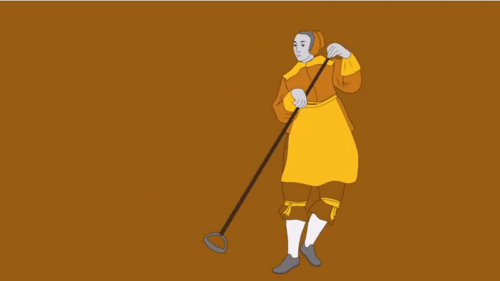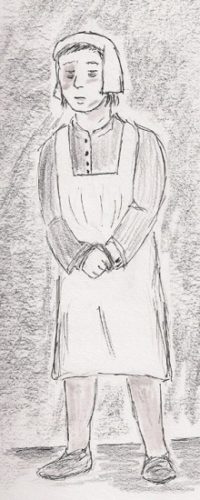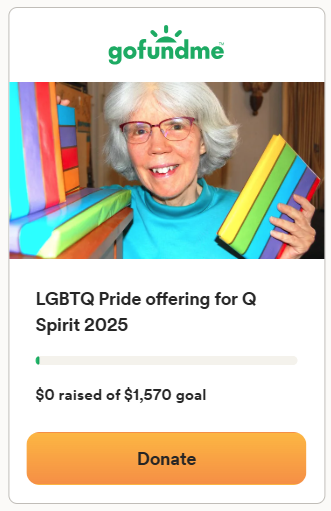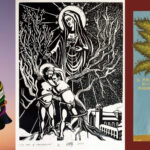Last Updated on October 24, 2024 by Kittredge Cherry

Thomas(ine) Hall was an intersex person in 17th-century colonial America who caused controversy by switching back and forth between genders. The Jamestown court ruled that Hall was both “a man and a woman” and ordered him/her to wear male and female clothing simultaneously.
Hall’s story is presented here for the “Fourteen Days of Intersex” between Intersex Awareness Day (Oct. 26) and Intersex Day of Remembrance (Nov. 8).

“Thomas or Thomasine Hall” by the Corpse Debutante
A baby was born in England around 1603, baptized by the name Thomasine and raised as a girl. Hall began alternating between male and female identities upon reaching adulthood. Hall cut his/her hair and served as a in the English military, fighting in France against Catholic persecution of the Protestant Huguenots. Next Hall earned a living as a woman doing needlework and making lace.
Hall heard of job opportunities in North America. Around 1626 s/he switched to male attire and took a ship to Virginia, where he worked as a male servant. Gossipy neighbors noticed that Hall changed between male and female dress and mannerisms, and rumors spread that Hall had both male and female sex partners.
Neighbors tried to settle the gender question with careful inspections of Hall’s body during sleep and at other times. Results were indeterminate, since Hall lacked a “readable set of female genitalia” and had a “small penis” (one inch long). Apparently Hall had the condition that modern society calls intersex or hermaphrodite.
An official inquiry was begun and reached the court of Jamestown, Virginia in 1629. With Governor John Pott presiding, the court heard from Hall and several witnesses. In the first such decision in early colonial history, the court ruled on April 8, 1629 that Hall had a “dual nature” and was both “a man and a woman.”
In Europe such cases had been resolved by forcing the person to adopt one gender permanently. But Hall was ordered to pay a fine and wear a mixed-gender outfit men’s clothing with a woman’s s cap and apron. The court’s goal was to subject Hall to shame and ridicule with this hybrid attire. Nothing definite is known about what happened later in Hall’s later life.
Hall’s history is told in “Thomas(ine) Hall, Gender Non-conforming in Colonial Virginia,” 2020 video and article from the New York Historical Society.
“The most alone soul in the world”
A portrait of Hall in her/her unisex attire was sketched by an artist who blogs under the pen name Corpse Debutante. “All we can really know is that Tom Hall must have been the most alone soul in the world at that moment, and furthermore, that s/he looked ridiculous,” Debutante wrote when posting the portrait on her blog.
There was no church yet in Jamestown at the time of Hall’s trial, but Jamestown settlers were members of the official Church of England. In contrast, the Plymouth colony in Massachusetts was founded by Puritans, who opposed the Church of England. Puritan theologians generally considered intersex people “abomination unto the Lord” (based on Deuteronomy 22:5) for threatening society’s use of clothing to distinguish men and women.
 Journalist Don Floyd wrote a historical novel based on Hall’s life titled “The Captain and Thomasine: Jamestown’s Intersexual Outcast Redeems A Patriot’s Dream.”
Journalist Don Floyd wrote a historical novel based on Hall’s life titled “The Captain and Thomasine: Jamestown’s Intersexual Outcast Redeems A Patriot’s Dream.”
Historians describe Hall’s life in books such as “Founding Mothers and Fathers: Gendered Power and the Forming of American Society” by Cornell University history professor Mary Beth Norton, a chapter by Kathleen M. Brown in “The Devil’s Lane: Sex and Race in the Early South” and a chapter by Mary Norton in “Through a Glass Darkly: Reflections on Personal Identity in Early America.”
Fourteen Days of Intersex
Intersex Awareness Day (Oct. 26) commemorates the first public demonstration by intersex people in North America. On Oct. 26, 1996, protesters gathered in Boston outside the annual conference of the American Academy of Pediatrics. Organizers had intended to speak at the conference to challenge the assumption that intersex children need cosmetic surgery, but security guards forced them out so they protested with a sign saying, “Hermaphrodites With Attitude.”
Two intersex-affirming hymns were written by Daniel Charles Damon in 2022 for a worship service observing Intersex Solidarity Day at The Table, an LGBTQIA+ centered faith collective in Nashville, Tennessee. Damon pastors First United Methodist Church in Richmond, California. The hymns are “Intersex People” and “O God, You Share Your Beauty.”
 Intersex Day of Remembrance, also known as Intersex Solidarity Day, occurs on Nov. 8 for the birthday of French intersex person Herculine Barbin. Philosopher Michel Foucault published her memoirs in “Herculine Barbin: Being the Recently Discovered Memoirs of a Nineteenth-Century French Hermaphrodite.”
Intersex Day of Remembrance, also known as Intersex Solidarity Day, occurs on Nov. 8 for the birthday of French intersex person Herculine Barbin. Philosopher Michel Foucault published her memoirs in “Herculine Barbin: Being the Recently Discovered Memoirs of a Nineteenth-Century French Hermaphrodite.”
Intersex Awareness Day tends to be celebrated in North America, while Europe emphasizes Intersex Day of Remembrance. Some countries honor both events and the whole period between as “Fourteen Days of Intersex.”
Intersex theology emerges and inspires
Innovative theologians are developing theologies that affirm intersex people and explore how intersex conditions can inspire church and society by challenging rigid religious assumptions. Their books include:

“Religion and Intersex: Perspectives from Science, Law, Culture and Theology” by Stephanie Budwey.
Theology provides reasons to open up the gender binary and embrace intersex people in a scholarly study that is built on interviews with German intersex Christians. The author is assistant professor of worship at Vanderbilt Divinity School in Nashville, Tennessee. Price warning: Kindle book is under $50, but print book is more than $100. Published by Routledge.
BESTSELLER AT JESUS IN LOVE
“Sex Difference in Christian Theology: Male, Female, and Intersex in the Image of God” by Megan K. DeFranza.
Recommended in the Intersex Christians group on Facebook. Solid theological analysis challenges the gender binary with Biblical resources on eunuchs and critiques various models of sexuality and gender based on images of Christ and God. Author Megan K. DeFranza shows that all people are made in God’s image: male, female and intersex. She has taught at Gordon-Conwell Theological Seminary. This was her first book, published by a major academic religious press (Eerdmans) and endorsed by queer scholars such as Susannah Cornwall.
“Sex and Uncertainty in the Body of Christ: Intersex Conditions and Christian Theology” by Susannah Cornwall.
Theological implications of physical intersex conditions and their medical treatment are examined. The book expands the meaning of incarnation and argues for a theology that encompasses stigmatized and marginalized bodies. This is the first systematic theology of the intersexed body, published in 2014. The author teaches theology at the University of Exeter in England.
“Intersex, Theology, and the Bible: Troubling Bodies in Church, Text, and Society” by Susannah Cornwall (editor).
Intersex people have been considered troubling because they are not easily classified as male or female, challenging the binary sex system of Western societies. Here scholars suggest that intersex people provide positive value by challenging dubious assumptions in religion and society. Writers consider intersex conditions from a range of perspectives, including constructive and pastoral theologies, biblical studies of eunuchs, and sociology of religion. The book features essays by Megan Shannon DeFranza, Joseph A. Marchal, Nathan Carlin and more. Cornwall is an advanced research fellow in theology and religion at the University of Exeter.
“Intersex in Christ: Ambiguous Biology and the Gospel” by Jennifer Anne Cox. Published by Wipf and Stock, 2018.
___
Related links:
“Seeing Eye to ‘I’: Celebrating Intersex Awareness Day with Thomas/ine Hall, an Intersex Virginian” by Ren Tolson (colonialwilliamsburg.org)
Jemima Wilkinson: Queer preacher reborn in 1776 as “Publick Universal Friend” (Q Spirit)
Sally Gross: Intersex South African priest led legal reform after being defrocked (Q Spirit)
“Intersexuality and Scripture” by Sally Gross, 1998 (Engender.org)
___
Top image credit: Video still from “Thomas(ine) Hall, Gender Non-conforming in Colonial Virginia,” a 2020 video from the New York Historical Society.
___
This post is part of the LGBTQ Saints series by Kittredge Cherry. Traditional and alternative saints, people in the Bible, LGBTQ martyrs, authors, theologians, religious leaders, artists, deities and other figures of special interest to lesbian, gay, bisexual and transgender and queer (LGBTQ) people and our allies are covered.
This article was originally published on Q Spirit in November 2016, was expanded with new material over time, and was most recently updated on Oct. 31, 2023.
Copyright © Kittredge Cherry. All rights reserved.
Qspirit.net presents the Jesus in Love Blog on LGBTQ spirituality.






















Jamestown was not a Puritan colony.
Thanks for the heads-up about Puritans. I didn’t say Jamestown was a Puritan colony, but readers might have drawn that wrong conclusion because of the way I mentioned Puritan theologians. I changed the wording to try to clarify the issue. Jamestown settlers were Anglican, so if you know what Anglican theologians were teaching about crossdressing in 1629 please enlighten me.